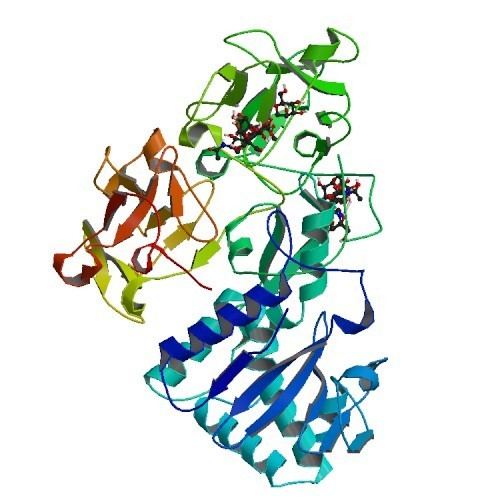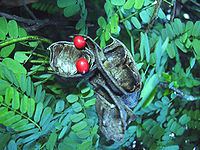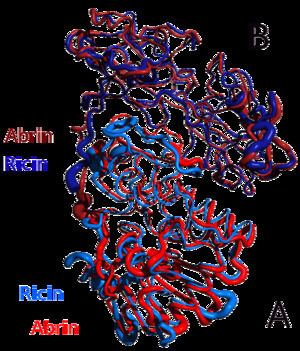 | ||
Definition of abrin abrin poison medical dictionary online
Abrin is a highly toxic toxalbumin found in the seeds of the rosary pea (or jequirity pea), Abrus precatorius. It has a median toxic dose of 0.7 micrograms per kilogram of body mass when given to mice intravenously (approximately 31.4 times more toxic than ricin being 22 micrograms per kilogram). The median toxic dose for humans ranges from 10 to 1000 micrograms per kilogram when ingested and is 3.3 micrograms per kilogram when inhaled.
Contents
- Definition of abrin abrin poison medical dictionary online
- Physical properties
- Use
- Toxicity
- Signs and symptoms of abrin exposure
- Inhalation
- Ingestion
- Absorption
- Treatment
- References

Abrin, like ricin, is a ribosome inhibiting protein and the toxin can also be found in the seeds of the castor oil plant. It is classed as a "Select Agent" under U.S. law.

Physical properties

Abrin is a water-soluble lectin. Abrin in powdered form is yellowish-white. It is a stable substance and can withstand extreme environmental conditions. Though it is combustible, it does not polymerize easily and is not particularly volatile.
Use

Abrin is not known to have been weaponised. Abrin naturally occurs in the seeds of the rosary pea, a plant common to tropical regions that is occasionally employed as an herbal remedy for certain conditions. While the outer shell of the seed protects its contents from the stomachs of most mammals, the seed coats are occasionally punctured to make beaded jewelry. This can lead to poisoning if a seed is swallowed, or if such jewelry is worn against damaged skin. Abrin has been shown to act as an immunoadjuvant in the treatment of cancer in mice.
Toxicity

Abrin works by penetrating the cells of the body and inhibiting cell protein synthesis. By attaching to a carbohydrate chain on the cell surface, the abrin molecule anchors itself to the cell, is subsequently engulfed and enters the inner parts of the cell where it reacts with a ribosomal subunit and interferes with the normal protein synthesis process of the cell. Without these proteins, cells cannot survive. This is harmful to the human body and can be fatal even in small exposures. The severity of the effects of abrin poisoning vary on the means of exposure to the substance (whether inhaled, ingested, or injected). Exposure to abrin on the skin can cause an allergic reaction, indicated by blisters, redness, irritation, and pain.
Signs and symptoms of abrin exposure

The major symptoms of abrin poisoning depend on the route of exposure and the dose received, though many organs may be affected in severe cases. In general, symptoms can appear anywhere between several hours to several days after exposure. Initial symptoms of abrin poisoning by inhalation may occur within 8 hours of exposure but a more typical time course is 18–24 hours; they can prove fatal within 36–72 hours. Following ingestion of abrin, initial symptoms usually occur rapidly, but can take up to 5 days to appear.

The later signs and symptoms of exposure are caused by abrin's cytotoxic effects, killing cells in the kidney, liver, adrenal glands, and central nervous system.
Inhalation

Within a few hours of inhaling abrin, common symptoms include fever, cough, airway irritation, chest tightness, pulmonary edema (excess fluid accumulated in the lungs), and nausea. This makes breathing difficult (called dyspnea), and the skin might turn blue in a condition called cyanosis, putting the person in respiratory distress. Excess fluid in the lungs can be diagnosed by x-ray or by listening to the chest with a stethoscope. As the effects of abrin progress, a person can become diaphoretic (sweating heavily) and fluid can build up further. Their blood pressure may drop dramatically, keeping oxygen from reaching the brain and other vital organs in a condition called shock, and respiratory failure may occur, which can be fatal within 36 to 72 hours. If an exposure to abrin by inhalation is not fatal, the airway can become sensitized or irritated.
Ingestion
Swallowing any amount of abrin can lead to severe symptoms. Early symptoms include nausea, vomiting, pain in the mouth, throat, and esophagus, diarrhea, dysphagia (trouble swallowing), and abdominal cramps and pain. As the symptoms progress, bleeding and inflammation begins in the gastrointestinal tract. The affected person can vomit up blood (hematemesis), have blood in their feces, which creates a black, tarry stool called melena, and more internal bleeding. Loss of blood volume and water from nausea, vomiting, diarrhea, and bleeding causes blood pressure to drop and organ damage to begin, which can be seen as the person begins to have somnolence/drowsiness, hematuria (blood in the urine), stupor, convulsions, polydipsia (excessive thirst), and oliguria (low urine production). This ultimately results in multi-system organ failure, hypovolemic shock, vascular collapse, and death.
Absorption
Abrin can be absorbed through broken skin or absorbed through the skin if dissolved in certain solvents. It can also be injected in small pellets and absorbed through contact with the eyes. Abrin in the powder or mist form can cause redness and pain in the eyes (i.e. conjunctivitis) in small doses. Small doses absorbed through the eyes can also cause tearing (lacrimation). Higher doses can cause tissue damage, severe bleeding at the back of the eye (retinal hemorrhage), and vision impairment or blindness. A large enough dose can be absorbed into the bloodstream and lead to systemic toxicity.
Treatment
Because no antidote exists for abrin, the most important factor is avoiding abrin exposure in the first place. If exposure cannot be avoided, the most important factor is then getting the abrin off or out of the body as quickly as possible. Abrin exposure can be prevented when it is present in large quantities by wearing appropriate personal protective equipment. Abrin poisoning is treated with supportive care to minimize the effects of the poisoning. This care varies based on the route of exposure and the time since exposure. For recent ingestion, administration of activated charcoal and gastric lavage are both options. Using an emetic (vomiting agent) is not a useful treatment. In cases of eye exposure, flushing the eye with saline helps to remove abrin. Oxygen therapy, airway management, assisted ventilation, monitoring, IV fluid administration, and electrolyte replacement are also important components of treatment.
